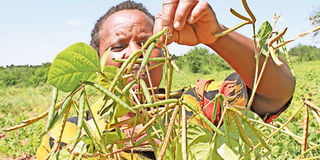Crops to farm at the Coast as rains get scarcer

A farmer inspects green-grams in a farm in Kitui in this past photo. Agriculture experts are urging coastal Kenya farmers to adopt climate-smart technologies and new crop varieties including green-grams, which are drought-tolerant to mitigate the effects. FILE PHOTO | NMG
What you need to know:
- Robert Musyoki, the sales and marketing manager at Simlaw Seeds, isolated green grammes as one of the crops that do well at the Coast.
- He also noted that cow peas (kunde) and amaranth (mchicha) are the other drought-tolerant crops that do very well in areas with high temperatures and humidity such as the Coast.
- For Tomato, the best varieties for the region include Nyota F1. An acre produces 40 tonnes, according to Musyoka.
- With cabbages, he said there is Escazu FI variety that is resistant to diseases and pests, matures in 70 to 75 days, and a farmer harvests 60 tonnes per acre with a mature cabbage weighing 4kg.
Water shortage, persistent pest infestation and diseases have made farmers at the Coast harvest losses.
Agriculture experts are, however, urging farmers to adopt climate-smart technologies and new crop varieties that are drought-tolerant to mitigate the effects.
Some of these technologies and crop varieties were on display at the recent ASK Mombasa show.
Robert Musyoki, the sales and marketing manager at Simlaw Seeds, isolated green grammes as one of the crops that do well at the Coast.
“The crop takes some 45 days to mature, and it only requires moisture during planting to make it germinate and during flowering to make it pod. An acre produces 80 bags, it is the new cash cow,” Musyoki said, identifying KS20 Pojo as the best variety to grow.
He also noted that cow peas (kunde) and amaranth (mchicha) are the other drought-tolerant crops that do very well in areas with high temperatures and humidity such as the Coast.
“For the two vegetables, you start harvesting at three weeks, making one to start earning faster. People are going for indigenous vegetables because they are rich in calcium, magnesium and iron. You can harvest for four months,” he adds.
To preserve the vegetables for up to a year, one can use a solar dryer that is readily available from Sh10,000 to Sh15,000. “The vegetables are best farmed organically, where there is no chemical use,” he said.
For Tomato, the best varieties for the region include Nyota F1. An acre produces 40 tonnes, according to Musyoka.
CONDUCIVE FOR THE CLIMATE
Kenya Plant Health Inspectorate Service senior inspector Timothy Ndolo said fall army worm and mango fruit fly are a threat to food security at the Coast and other parts of the country. The entomologist said farmers should use pheromone traps to curb the pests.
“The trap has hormones that lure the male pest and once it gets inside, it is killed by an insecticide. This leaves the female adults without males to mate, hence no multiplication,” he explains.
Fahari F1 watermelon variety is among those doing well at the Coast.
“It is conducive for this region’s climate, and it takes two months to mature, unlike in other areas across the country,” said Joram Kaindi from Sygenta.
The crop yields an 8kg fruit, is disease-tolerant and suitable for open-field planting.
With cabbages, he said there is Escazu FI variety that is resistant to diseases and pests, matures in 70 to 75 days, and a farmer harvests 60 tonnes per acre with a mature cabbage weighing 4kg.
Kenya Agricultural and Livestock Research Organisation showcased 10 sugar cane varieties, including D8484, which are suitable for farming in the region. Other cash crops include bixa and sisal.
Paul Kisiangani, a horticulturalist with Agribusiness Youth Society of Kenya, urged farmers to grow pawpaws and pineapples, noting they do well in the region and fetch more.
“One should plant crops that do not require much rainfall. Hybrid varieties are high-yielding and conducive for the climate,” Mr Kisiangani said.





